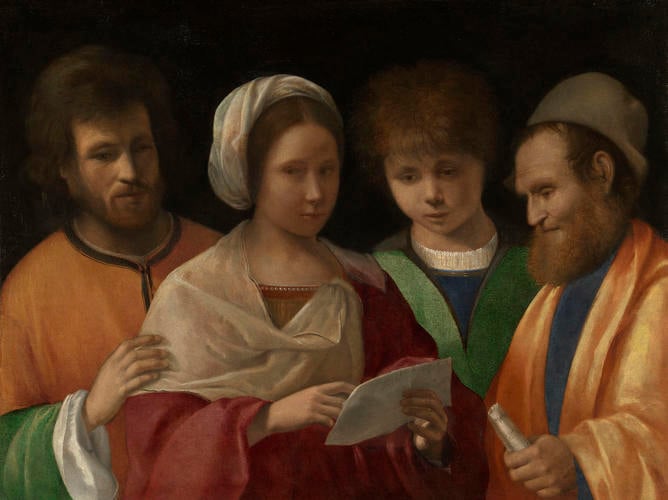-
1 of 253523 objects
The Concert c. 1505-15
Oil on canvas | 77.8 x 99.8 x 2.0 cm (support, canvas/panel/stretcher external) | RCIN 400025

Attributed to Vittore Belliniano (active 1507-29)
The Concert c. 1505-15
-
The figures in this haunting painting, formerly attributed to Giorgione, are singing from a score held by the woman, who beats time with her finger. Both the subject and authorship of the painting have been widely debated; the figures may represent the three ages of man - childhood, ‘the prime of life’ and old age.
The artist is probably not Giovanni Bellini himself, but his pupil, Vittore di Matteo, who assumed the name ‘Belliniano’ in honour of his master and who (like all Venetian artists at this date) fell under the influence of Giorgione. There are a few signed works, and on this basis other paintings have been attributed to Belliniano. The soft, mysterious lighting can be found in his signed Man Praying in front of the Crucifixion of 1518 (Accademia Carrara, Bergamo). Very similar heads appear in the large Martyrdom of St Mark of 1515-26 (Accademia, Venice), begun by Bellini and completed and signed by Belliniano. The warm light in the Martyrdom creates the same suggestive shadows on buildings and faces as appear in this painting. Belliniano’s Madonna with Saints (Museo Correr, Venice) has similar facial types, flat folds of drapery and soft play of light creating interesting shadows.
Although not a concert in the modern sense of a public performance, the four participants are probably singing from a score held by the central woman. Sketchy indications of musical notation can be seen on the open and rolled sheets of music; the ages and sexes of the figures suggest the four parts of traditional harmony; the woman seems to be beating time by tapping her index finger, as was contemporary practice. Their dress is modest rather than fashionable: the woman wears a simple cap and shawl (camicia) around her shoulders of a type worn in Venice by respectable middle-class women, though usually older than this one.
In subject and style the painting is closely related to Giorgione's Three Ages of Man (Palazzo Pitti, Florence), which depicts a similar ensemble of three singers. The three ages are also the subject of Titian’s famous painting (National Gallery of Scotland) in which an amorous music-making couple inhabits a landscape with children and an old man. The idea of ‘measuring time’, both here and in Giorgione’s Three Ages of Man, has a philosophical as well as a musical dimension.Provenance
Gerard Reynst, Amsterdam; acquired by the States of Holland and West Friesland and presented to Charles II in 1660
-
Creator(s)
Acquirer(s)
-
Medium and techniques
Oil on canvas
Measurements
77.8 x 99.8 x 2.0 cm (support, canvas/panel/stretcher external)
73.0 x 95.0 cm (support (etc), excluding additions)
88.5 x 112.3 x 6.5 cm (frame, external)
Category
Object type(s)